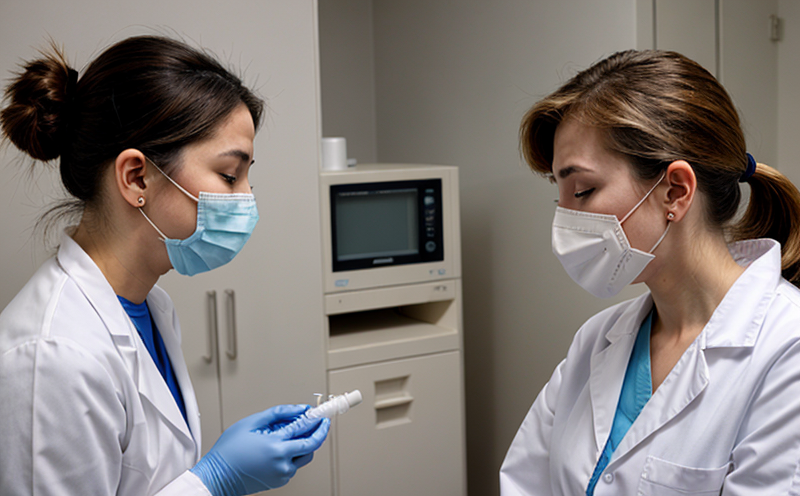Endotoxin Detection Testing in Environmental Air Samples
In clinical and healthcare settings, maintaining a clean and safe environment is paramount. One critical aspect of this endeavor is the monitoring of endotoxins in environmental air samples. Endotoxins are components derived from Gram-negative bacteria and can trigger an immune response that may be harmful if present at high levels. This service focuses on detecting these potentially hazardous substances through rigorous testing procedures.
The importance of endotoxin detection extends beyond mere compliance; it directly impacts patient safety, especially in hospitals where compromised immune systems are common among patients. By ensuring air quality meets stringent standards, healthcare facilities can mitigate risks associated with airborne contaminants and protect vulnerable populations.
Endotoxins are typically detected using quantitative chromogenic methods, which involve the use of a chromogenic substrate that changes color upon binding to endotoxin. This reaction is then quantified via spectrophotometry or luminometry. The process starts by collecting air samples in specialized sampling devices designed to capture airborne particles efficiently.
The collected samples are then prepared for analysis, which includes diluting the sample and incubating it under controlled conditions. During this phase, any endotoxins present will interact with the chromogenic substrate, leading to a detectable change. Once the reaction has reached its endpoint, the absorbance or luminescence is measured using appropriate instrumentation.
Interpreting these measurements involves comparing them against established limits set by regulatory bodies like the European Pharmacopoeia (EP) and USP guidelines. These limits are based on the expected safe levels of endotoxins in various environments, such as hospital cleanrooms or sterile manufacturing areas.
Understanding how environmental factors affect endotoxin levels is crucial for accurate testing. Factors like temperature, humidity, and air flow can influence both the concentration and stability of endotoxins in air samples. Therefore, it’s essential to maintain consistent conditions during sampling and analysis to ensure reliable results.
Compliance with international standards such as ISO 12207-3:2015 for pharmaceutical products or ASTM E846-18 for medical devices is vital in this context. Adhering to these specifications ensures that the testing methods used are validated and recognized globally, enhancing credibility and acceptance of results.
- Q: What kind of equipment is required for endotoxin detection?
- A: The primary equipment includes specialized sampling devices for capturing air samples, dilution units for preparing the sample, and spectrophotometers or luminometers capable of measuring chromogenic reactions.
Scope and Methodology
The scope of this service encompasses both sampling strategies and analytical techniques used to detect endotoxins in environmental air samples. Sampling involves selecting appropriate locations within healthcare facilities where air quality is most critical, such as patient rooms or operating theaters.
Sampling devices must be capable of collecting sufficient quantities of airborne particulates without altering their composition significantly. After collection, samples are transported to the laboratory under specified conditions to prevent degradation.
The analytical methodology follows a series of steps designed to yield accurate and reproducible results. This includes thorough preparation of each sample, ensuring that all components interact optimally with the chromogenic substrate. Proper calibration of instruments is also crucial for obtaining reliable measurements.
- Q: Why are sampling conditions critical in endotoxin detection?
- A: Sampling conditions directly impact the integrity and quantity of airborne particles captured, influencing the accuracy of subsequent tests. Proper temperature control and minimizing exposure to light help maintain sample stability.
Eurolab Advantages
Eurolab stands out in providing endotoxin detection services due to its expertise, advanced equipment, and adherence to international standards. Our team of professionals is well-versed in the latest techniques, ensuring accurate and timely results every time.
We offer comprehensive support from initial consultation through final report delivery, making sure clients understand not just what the data means but also how it can be leveraged for improvement. With our state-of-the-art facilities, we guarantee precision and reliability across all services offered.
Environmental and Sustainability Contributions
- Q: How does endotoxin detection contribute to environmental sustainability?
- A: By detecting and reducing airborne contaminants, this service plays a role in improving indoor air quality, which can lead to healthier living environments. This contributes positively towards sustainable building practices.
Ensuring that healthcare facilities meet strict endotoxin limits helps create safer spaces for both staff and patients, contributing indirectly to overall public health improvements. Additionally, the use of standardized testing ensures consistency across industries, promoting best practices in environmental management.





